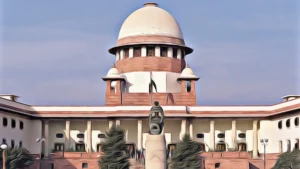
Why in News?
- The Supreme Court of India (SC) recently marked its 75th anniversary, known as the Diamond Jubilee Celebration, at the Supreme Court Auditorium in Delhi.
- This milestone aligns with the 75th anniversary of the Indian Constitution.
- During the event, various citizen-focused information and technology initiatives were introduced, all geared towards improving judicial accessibility and transparency.
What are the main highlights of the event?
- Key highlights of the event included the launch of digital initiatives like the Digital Supreme Court Reports (Digi SCR) and Digital Courts 2.0, as well as the unveiling of a revamped Supreme Court website.
- Digi SCR offers free electronic access to Supreme Court judgments since 1950, while Digital Courts 2.0 leverages AI for real-time transcription.
- The bilingual Supreme Court website enhances user experience, and efforts to improve accessibility to justice, along with investments in physical infrastructure, were also emphasized.
Key highlights concerning the Supreme Court
- Establishment:
- The Supreme Court came into existence on January 28, 1950, just two days after India became a Sovereign Democratic Republic.
- It replaced the Federal Court of India, established under the Government of India Act of 1935, and expanded its jurisdiction to include that of the British Privy Council as the highest court of appeal.
- Constitutional Provisions:
- Articles 124 to 147 in Part V of the Constitution cover the organization, independence, jurisdiction, powers, and procedures of the Supreme Court, with the Parliament authorized to regulate them.
- Current Composition:
- The Supreme Court of India comprises 34 judges, including the Chief Justice of India, all appointed by the President.
- The original 1950 Constitution envisioned a Supreme Court with a Chief Justice and 7 puisne Judges, with the provision for Parliament to increase this number.
- Appointment:
- The President appoints the Chief Justice of India after consulting with select judges from the Supreme Court and High Courts.
- Other judges are appointed after consulting with the Chief Justice and additional judges from the Supreme Court and High Courts.
- Consultation with the Chief Justice of India is mandatory for the appointment of any judge other than the Chief Justice.
- Eligibility Criteria for Appointment:
- To become a Supreme Court Judge, a person must be an Indian citizen and have served as a High Court Judge for at least five consecutive years, or as a High Court Advocate for at least ten consecutive years, or be recognized as a distinguished jurist by the President.
- There is no minimum age prescribed, but judges retire at the age of 65 and are prohibited from practicing post-retirement.
- Removal of Judges:
- A judge can be removed from office by an order of the President, following an address by Parliament presented in the same session.
- The address must be supported by a special majority of each House of Parliament on grounds of proven misbehavior or incapacity.
- Language of Proceedings and Regulation:
- Proceedings in the Supreme Court are conducted solely in English, with rules framed under Article 145 of the Constitution governing its practice and procedure, including the Supreme Court Rules of 1966 and 2013.
Independence of the Supreme Court:
- Fixed Service Conditions:
- Judges’ salaries, allowances, and benefits are determined by Parliament, ensuring stability unless altered during a financial emergency.
- These expenses are drawn from the Consolidated Fund, making them non-votable by Parliament and securing financial independence.
- Conduct Immunity:
- Parliament and State Legislatures cannot discuss judges’ conduct, except during impeachment proceedings (Article 121).
- Contempt Power:
- The Supreme Court has the authority to punish contempt, ensuring respect for its decisions and authority (Articles 129).
- Staff Appointment Autonomy:
- The Chief Justice of India can appoint Supreme Court staff and determine their service conditions, without executive interference.
- Jurisdiction Protection:
- Parliament cannot diminish the Supreme Court’s jurisdiction, although it can extend it.
- Separation from Executive:
- The Constitution mandates the separation of the judiciary from the executive in public services, ensuring no executive influence in judicial matters upon implementation (Article 50).
FAQs
Q1: Why is the independence of the Supreme Court important?
Ans: The independence of the Supreme Court ensures that it can act impartially and without influence from other branches of government. This allows for fair and just interpretation of laws and protection of constitutional rights.
Q2:How is the independence of the Supreme Court maintained?
Ans: The Supreme Court’s independence is maintained through various mechanisms such as fixed service conditions for judges, immunity from discussions on their conduct except during impeachment proceedings, and the power to punish contempt. Additionally, the separation of the judiciary from the executive and financial autonomy further ensure independence.
Q3: What role does the Supreme Court play in upholding its independence?
Ans: The Supreme Court plays an active role in upholding its independence by exercising its powers judiciously, ensuring transparency in its proceedings, and safeguarding its jurisdiction. It also relies on constitutional provisions and legal precedents to maintain its autonomy and authority.